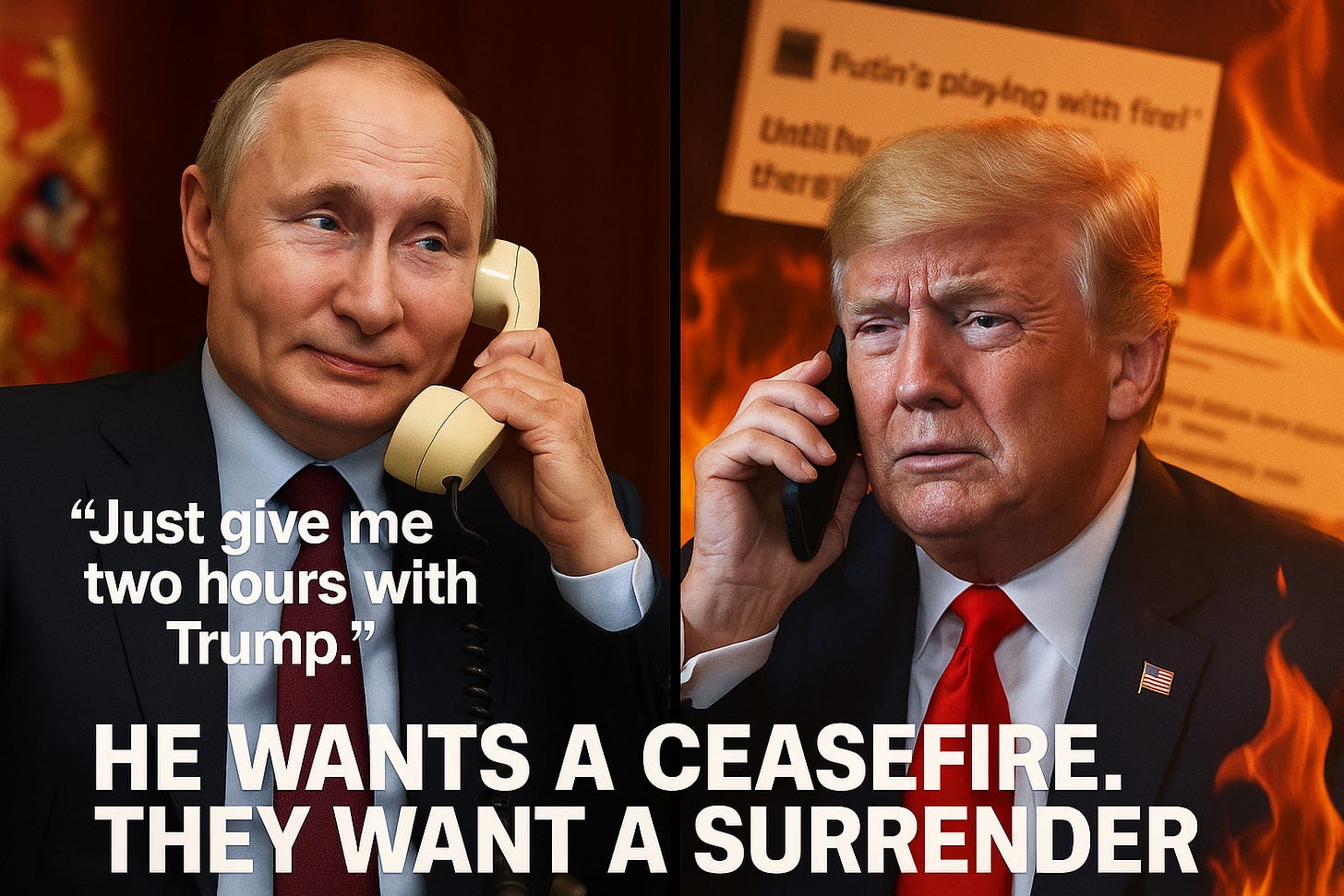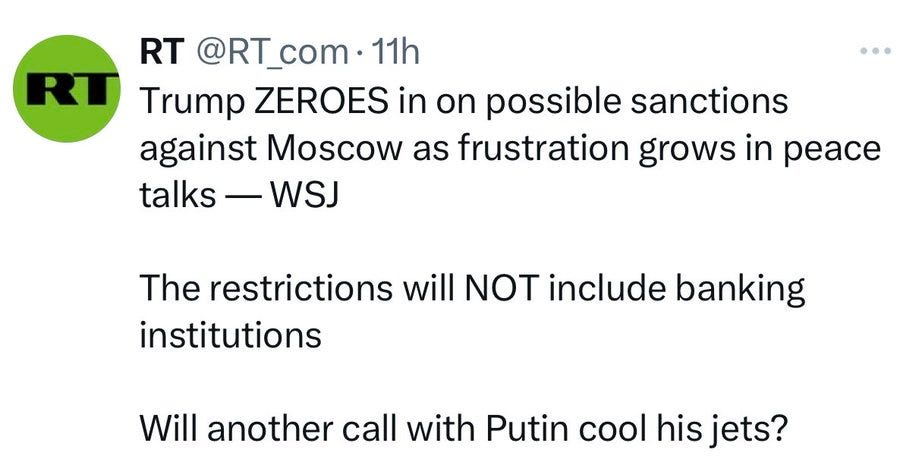Putin’s Playing Trump Like a Fiddle—And Europe’s Still Waiting for Permission
State media mockery, G7 sabotage, and the one $8 billion missile order that could finally break the Kremlin’s grip.
After months under a Kremlin-imposed gag order, Russia’s state media has finally been unleashed—and they’re mocking Donald Trump in a coordinated blitz.
The Kremlin mouthpiece RT took aim at Trump’s latest social media post with this jab:
President Trump warns Moscow, claiming Russia avoided ‘Really Bad’ consquences only thanks to him.
‘Putin doesn’t realize….he’s playing with fire!’ — Trump’s message leaves little room for misinterpretation
Until he posts the opposite tomorrow morning.
RT didn’t stop there. They followed up with another shot.
As RT piled on—mocking both Trump’s social media posts and his recent calls with the Russian dictator—Putin’s longtime enforcer Dmitry Medvedev issued a blunt warning:
Regarding Trump's words about Putin "playing with fire" and "really bad things" happening to Russia. I only know of one REALLY BAD thing — WWIII. I hope Trump understands this!
None of this is accidental. It’s a calculated, deliberate strategy—and the timing is no coincidence. It came immediately after the Trump administration unveiled what can only be described as its Putin protection plan at the recent G7 meeting.
On May 27th, the Financial Times reported that the United States opposed a joint G7 effort to lower the $60-per-barrel price cap on Russian oil exports. The Canadian G7 presidency had proposed adding language to the final communique calling for a tighter cap. The idea was backed by the European Union, France, Germany, Italy, and the U.K.—but it was dropped after U.S. Treasury Secretary Scott Bessent reportedly refused to support it.
The European Commission had prepared a proposal to drop the cap to between $45 and $50 per barrel.
Had this gone through, it would have put serious strain on the Russian economy and slowed the Kremlin’s war machine. Instead, the Trump administration—despite claiming neutrality and urging Ukraine and Russia to negotiate—intervened to shield Moscow’s daily oil and gas revenue.
And the timing couldn’t have been better to lower the price cap. Global oil markets are stable, WTI Brent is hovering around $60 per barrel. Imposing a lower cap now would’ve been one of the lowest-hanging strategic fruits available. The Trump team just ripped it off the tree and handed it back to Putin.
Enjoying this level of analysis? I break down military strategy, geopolitical shifts, and leadership decisions with zero fluff — just facts, context, and consequences.
Your support is how The Concis moves forward.
And right on cue—during the G7 summit—Russian state media began mocking Donald Trump, while Kremlin officials escalated with open threats of World War III. This isn’t random. It’s a two-pronged pressure campaign. If Trump keeps flinching, the Kremlin will keep pressing.
They’ve already found the soft spot: Trump wants a ceasefire. It plays well domestically for Trump, and Putin knows it. Dangle the illusion of peace long enough, and Trump becomes manageable. It’s worked flawlessly since February. Whenever things get dicey, all Putin needs is a two-hour call with Trump, a vague promise of ceasefire—and suddenly, Zelensky gets verbally attacked, or new sanctions stall in Washington.
Now, by escalating to nuclear threats, they’re testing Trump’s resolve. If he folds again—say, by torpedoing GOP-backed sanctions—the Kremlin will take that as a green light to keep bullying.
If the bluff fails, Putin will simply reset the board with another “ceasefire” call.
Let’s be clear: Putin isn’t just manipulating Trump. He’s playing him like a fiddle. One crack in the armor, and the Kremlin starts probing for the next. As long as Trump blocks sanctions and shields Russian oil profits, Putin sees no reason to stop. No reason to pull back. On the contrary—he’s already telling Russians: this is just the beginning. Yes. The three year war is just the beginning.
This isn’t speculation. It’s already happening on the ground—and the Institute for the Study of War (ISW) confirmed it just this morning:
Putin continues to use orchestrated public engagements to forward the Kremlin's effort to create a militarized Russian society united against the West that supports a prolonged war in Ukraine and possible future conflict with NATO.
Putin met with the supervisory board of the state-formed "Russia-Land of Opportunities" non-profit organization on May 27 and spoke with participants of the organization's programs during a highly scripted event.
Putin claimed that many foreigners see Russia as a "stronghold" of traditional spiritual and moral values. Putin claimed that Soviet citizens' "spirit of devotion to their people" formed the basis of the Soviet victory in the Second World War and stated that the "internal mobilization" of each Russian citizen and Russian society as a whole is the most important thing right now for Russia.
Putin stated that the future of a state depends on its independence, sovereignty, and self-sufficiency; that Russia will not exist if it is not sovereign; and that "passion within society" is important for Russian sovereignty.
It’s not surprising. Putin is facing two brutal options: his economy could implode if he ends the war—or implode because he keeps it going. He’s risking the latter.
Why? Because he believes Trump is malleable. Manageable. Playable.
And he’s not wrong. The clearest proof? Trump’s team blocking the EU’s effort to lower the Russian oil price cap at the G7. That wasn’t just bad policy. It was a signal to the Kremlin: Trump can still be used.
What can Europe do about this?
Yesterday, confusion erupted over Chancellor Merz’s statement that long-range restrictions on weapons for Ukraine had been relaxed. The debate bounced back and forth inside Germany. But let’s not approach this the way legacy media does. Let’s look at the actual battlefield constraints.
When Ukraine crossed into Russia’s Kursk oblast, it did so using exclusively European-supplied weapons. Not a single American weapons system crossed the border on August 7th, 2024. It was only weeks later that U.S. weapons showed up on the other side—and even longer before the Biden administration officially loosened its restrictions on Ukraine striking targets inside specific Russian territory.
Even now, Ukraine is constrained in how it can use American systems. The only U.S. long-range weapon they have for such strikes is the ATACMS, fired from HIMARS launchers. But the U.S. never delivered these in meaningful quantity.
So what can Ukraine actually use to hit deep inside Russia?
Maybe British Storm Shadows or French SCALPs, launched from jets. But the total number of these missiles is small—and the max range for any of them is about 300 kilometers. Trump isn’t going to send hundreds of ATACMS. Britain and France aren’t producing enough of their systems to meet demand. And there’s zero chance Trump will ever authorize delivery of Tomahawks, which can hit targets 2,400 kilometers away.
So what “long-range restriction” debate are we really having? We’re talking about sub-300km missiles that exist in extremely limited supply.
Taurus is the only missile in Europe’s arsenal right now that can hit up to 500 kilometers—and it’s air-launched. But it hasn’t hit scaled production yet. If Europe wants to give Ukraine a real strike capability, this is it. Taurus is the only viable option. And it needs to be delivered in growing, steady volume.
So yes, it’s pointless to attack Merz for saying restrictions have been lifted. The truth is: there’s barely anything to restrict. If you really want to criticize him, hold him accountable for not placing a massive $8 to $10 billion order to scale up Taurus missile production. That’s the one move he can make—and he hasn’t done it yet. Maybe such an order could be placed quietly, under the radar. If so, great. But until it happens, Germany is still holding back Europe’s only independent long-range option.
And here’s the real crux: once that Taurus order is placed and monthly production ramps up, why does Europe need U.S. permission to hit Russian targets?
It doesn’t.
That’s the point. This isn’t just about missile range—it’s about Europe finally stepping up and acting like it doesn’t need Washington’s permission to defend itself. For years, escalation thresholds were outsourced to the United States.
That era must end. And it truly ends when Merz signs the $8 billion Taurus order. Until then, the rest is just noise.
Still reading? That counts. Hit the ♥️ or pass this along to someone who should see it.






German media report that Germany will invest in Ukraine to help it develop long-range missiles with a range of 2,500 kilometers.
The entire Free World now depends on German military production!
This one of history’s biggest ironies!
Let’s hope that Europe steps up to its new role as leader of the Free World!